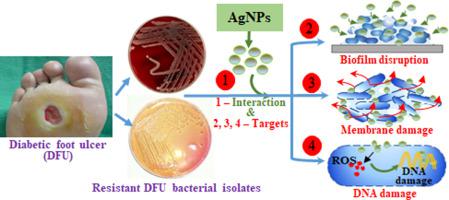Biomaterials Advances ( IF 5.5 ) Pub Date : 2020-07-04 , DOI: 10.1016/j.msec.2020.111256 Selvakumar Thanganadar Appapalam 1 , Benedict Paul 2 , Sumathy Arockiasamy 3 , Rajasekar Panchamoorthy 1

|
The present study selected the predominant multi antibiotic-resistant diabetic foot ulcer (DFU) derived bacterial isolates such as Pseudomonas aeruginosa (PA), Escherichia coli (EC), Staphylococcus aureus (SA) and Bacillus subtilis (BS) and evaluated their response against the well-characterized Aerva lanata (AL) reduced multiple phytochemicals fabricated silver nanoparticles (AL-AgNPs). The overnight culture of DFU isolates was processed and subjected to various studies such as antimicrobial activity, growth kinetics, biofilm disruption, reactive oxygen species (ROS), membrane leakage, membrane permeability, and damage and genotoxicity. The molecular docking of AL phytochemicals was also performed with bacterial enzyme DNA gyrase. Interestingly, AL-AgNPs were produced the remarkable antibacterial effect against the resistant DFU isolates, which was closely similar to the effect of AL-AgNPs observed against the reference strains. The minimum inhibitory concentration (MIC) and minimum bactericidal concentration (MBC) of AL-AgNPs against the DFU isolates were found to be 5–15 μg/mL and 10–20 μg/mL, respectively. The AL-AgNPs were depicted a concentration-dependent growth inhibition of DFU bacterial isolates. The MIC and MBC of AL-AgNPs were effectively destroyed the preformed biofilms of DFU isolates. Furthermore, the MBC of AL-AgNPs was displayed the increased intracellular ROS accumulation, membrane leakage, permeability and damage, and genotoxicity in the DFU isolates. Additionally, the in silico study revealed that the AL phytochemicals were fitted over the binding pocket of the DNA gyrase B subunit. The observed results were confirmed that the negative impacts of the AL-AgNPs at the level of the membrane and intracellular components of DFU isolates.
中文翻译:

植物精制银纳米颗粒:发现针对糖尿病足溃疡的耐药菌分离物的抗菌靶标。
本研究选择了主要的多抗生素抗性糖尿病足溃疡(DFU)衍生的细菌分离株,例如铜绿假单胞菌(PA),大肠杆菌(EC),金黄色葡萄球菌(SA)和枯草芽孢杆菌(BS),并评估了它们对细菌的反应特有的Aerva lanata(AL)减少了多种植物化学制品制得的银纳米颗粒(AL-AgNPs)。处理DFU分离物的过夜培养物,并进行了各种研究,例如抗微生物活性,生长动力学,生物膜破坏,活性氧(ROS),膜泄漏,膜通透性以及损害和遗传毒性。AL植物化学物质的分子对接也通过细菌酶DNA旋转酶进行。有趣的是,AL-AgNPs对耐药性DFU分离物产生了显着的抗菌作用,这与观察到的AL-AgNPs对参考菌株的作用非常相似。发现AL-AgNP对DFU分离物的最小抑菌浓度(MIC)和最小杀菌浓度(MBC)分别为5-15μg/ mL和10-20μg/ mL。AL-AgNPs描绘了DFU细菌分离株的浓度依赖性生长抑制。AL-AgNPs的MIC和MBC被有效破坏了DFU分离物的预先形成的生物膜。此外,AL-AgNPs的MBC在DFU分离物中显示出增加的细胞内ROS积累,膜渗漏,通透性和损伤以及遗传毒性。此外,在计算机研究中发现,AL植物化学物质安装在DNA促旋酶B亚基的结合口袋上。观察到的结果证实了AL-AgNP对DFU分离株的膜和细胞内组分水平的负面影响。











































 京公网安备 11010802027423号
京公网安备 11010802027423号